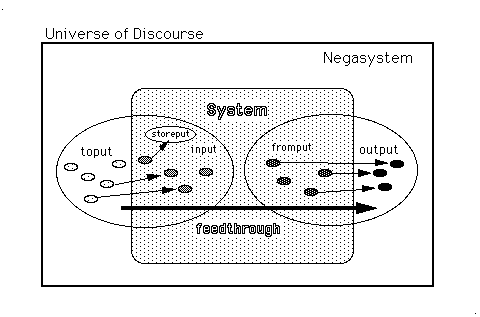 Educational Systems Theory
Educational Systems Theory
Property: Efficiency (EF)
Definition:
-
"Educational system efficiency is commonalty between feedthrough and toput."
Comments:
- Feedthrough is: feedin at time 1, and then, feedout at time 2. Toput is the education system's choice environment. Thus system efficiency is the commonalty between what is made available to the system for selection, and what the system takes in and
what the negasystem takes out at a later time (from what the system makes available)
- Efficiency, therefore, is the commonalty between what a system takes in (from its choice environment) and what the negasystem accepts back out from the system, at some later time. It may be defined by an information measure.
- Formally: EF is defined as = B(FT,TP), where B is the information-theoretic measure of commonalty.
Illustration:
- This Figure depicts a highly efficient educational system. All of what is available is fed in to the system, and all of what the system makes available is fed out to the negasystem. The system would be less efficient if some of the toput never becom
es input, and some of the fromput does not become output.

Examples:
- Suppose that 500 students apply for admission to an higher educational system, but only 50 are admitted (say, those who have the highest SAT scores). Of those 50, some drop out during their educational program.
At some later time, 35 students finish their program and graduate. Of those 35, 20 students find jobs (the remainder join the ranks of the unemployed). We would say that this educational system is less than perfectly efficient.
- Consider another sort of educational system, say an elite private high school. Only people who can afford the tuition have their kids apply, but because of the strong self-selection, the school can admit virtually all of them without sacrificing their
standards. Further, socio-economic factors and the large monetary investment almost preclude students dropping out.
Later, when these students graduate, virtually all of them are admitted to higher education, (though perhaps not always to their first choice of college). Such a system could be said to be very efficient. Note that the cost per pupil is likely to be high
er than public school so in economic terms, it may not be very cost effective.
- There is an alternative educational system that displays both good system efficiency and improved cost effectiveness, it is called the Montessori System. By incorporating much of the instruction into the design of learning materials and related class
work, this system "produces" students who have high mean achievement levels. Moreover, it is able to do so for about one half the per-pupil cost of traditionally structured public primary schools.
Related Terms:
- Toput (def.)
- Feedthrough (def.)
- Commonalty (B) (def.)
- Storeput (H #18, #44)
- Input (H #41)
- Fromput (H #44)
- Compactness (H #104, #139, #191)
- Wholeness (H #113)
- Hierarchical Order (H #113)
- State Determination (H #191)
Hypotheses Containing the Property: EF
- #18
- #41
- #104
- #113
- #139
- #191
Terms Similar to EF:
- Adaptability
- Compatibility
- Openness
Go to the top of this document.
 Go to SIGGS Home Page.
Go to SIGGS Home Page.
Last updated by John Beckerman,
4/4/95.
 Educational Systems Theory
Educational Systems Theory Educational Systems Theory
Educational Systems Theory
 Go to SIGGS Home Page.
Go to SIGGS Home Page.